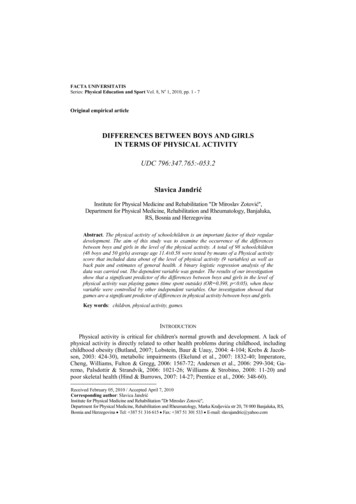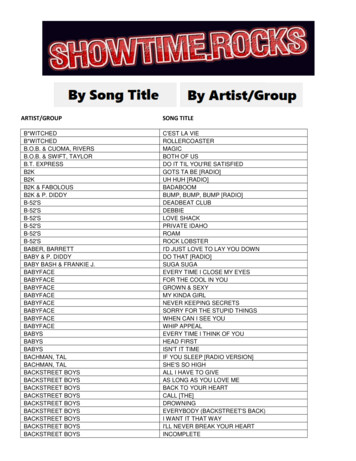
Transcription
FACTA UNIVERSITATISSeries: Physical Education and Sport Vol. 8, No 1, 2010, pp. 1 - 7Original empirical articleDIFFERENCES BETWEEN BOYS AND GIRLSIN TERMS OF PHYSICAL ACTIVITYUDC 796:347.765:-053.2Slavica JandrićInstitute for Physical Medicine and Rehabilitation "Dr Miroslav Zotović",Department for Physical Medicine, Rehabilitation and Rheumatology, Banjaluka,RS, Bosnia and HerzegovinaAbstract. The physical activity of schoolchildren is an important factor of their regulardevelopment. The aim of this study was to examine the occurrence of the differencesbetween boys and girls in the level of the physical activity. A total of 98 schoolchildren(48 boys and 50 girls) average age 11.4 0.58 were tested by means of a Physical activityscore that included data about of the level of physical activity (9 variables) as well asback pain and estimates of general health. A binary logistic regression analysis of thedata was carried out. The dependent variable was gender. The results of our investigationshow that a significant predictor of the differences between boys and girls in the level ofphysical activity was playing games (time spent outside) (OR 0.398, p 0.05), when thesevariable were controlled by other independent variables. Our investigation showed thatgames are a significant predictor of differences in physical activity between boys and girls.Key words: children, physical activity, games.INTRODUCTIONPhysical activity is critical for children's normal growth and development. A lack ofphysical activity is directly related to other health problems during childhood, includingchildhood obesity (Butland, 2007; Lobstein, Baur & Uauy, 2004: 4-104; Krebs & Jacobson, 2003: 424-30), metabolic impairments (Ekelund et al., 2007: 1832-40; Imperatore,Cheng, Williams, Fulton & Gregg, 2006: 1567-72; Andersen et al., 2006: 299-304; Garemo, Palsdottir & Strandvik, 2006: 1021-26; Williams & Strobino, 2008: 11-20) andpoor skeletal health (Hind & Burrows, 2007: 14-27; Prentice et al., 2006: 348-60).Received February 05, 2010 / Accepted April 7, 2010Corresponding author: Slavica JandrićInstitute for Physical Medicine and Rehabilitation "Dr Miroslav Zotović",Department for Physical Medicine, Rehabilitation and Rheumatology, Marka Kraljevića str 20, 78 000 Banjaluka, RS,Bosnia and Herzegovina Tel: 387 51 316 615 Fax: 387 51 301 533 E-mail: slavajandric@yahoo.com
2S. JANDRIĆResearch studies confirm the health benefits of regular physical activity. Increasingphysical activity and improving dietary habits in childhood have therefore been identified astargets for future public health policies (Butland, 2007; Department of Health, 2004). Thiswill help the identification of populations at risk and the development of interventions topromote change in these health behaviours. Previous studies have reported mixed results,with the proportion of children achieving the recommended guideline of at least one hour ofmoderate-to vigorous intensity physical activity (MVPA) each day (11) varying from 2,5 to97% (Department of Health, 2004; Riddoch et al.,2004: 86-92; Riddoch et al., 2007: 96369; Pate et al., 2002: 303-8; Spinks, Macpherson, Bain & McClure, 2007: 156-63).This large variation mainly depends on the population studied and the variation in theapplied data processing methods. However, most studies indicate that physical activity levelsdecline with age, especially during late primary school years (Sallis, Prochaska & Taylor,2000: 963-75; Sherar, Esliger, Baxter-Jones & Tremblay, 2007: 830-35; Kimm et al.,2002:709-15), making this a potentially important period for health promotion interventions. Previous studies are focused on physical activity and dietary behavior of 9-10-year old Britishchildren (Van Sluijs, Skidmore, Mwanza, Jones, Callaghan, 2008: 388), ethnic and genderdifferences in physical activity levels among 9–10-year-old children (Van Sluijs, 2008: 388),overweight children (Binns et al., 2009: 591-1598; Maddison, 2009: 146), physical activityand good health (Blair, Kohl, Gordon & Paffenbarger, 1992: 99-126), association of bloodpressure with BMI, physical activity and cardio respiratory fitness in youth (Gaya et al.,2009: 1-9). The SPEEDY study (Sport, Physical activity and Eating behavior: Environmental Determinants in Young people) was established to examine physical activity levelsand dietary behavior in a large population-based sample of British 9–10 year old children,and to investigate the individual and collective factors associated with these behaviors.Although there is some information available on the physical activity of school agedchildren (Kimm et al.,2002: 709-15; Van Sluijs, Skidmore, Mwanza, Jones, Callaghan, 2008:388), little is known about the differences between boys and girls in terms of physical activity.The aim of this investigation was to examine the occurrence of the differences between boysand girls in the level of the physical activity among schoolchildren aged 11-12 years.METHODSNinety-eight schoolchildren (48 boys and 50 girls) were included in this study. Theaverage age of the children was 11, 4 0, 58 (Table 1).Table 1. Characteristics of the study sample (n 98)ParameterAverage age TotalN0%9810011.40.58All the children were tested by a Physical activity score that included data regarding thelevel of time spent studying, sedentary screen-based activities (video gaming, computerscience), physical education classes, corrective exercises, playing games (time spent outside),
Differences between Boys and Girls in Terms of Physical Activity3sports activities, training, warming up before training and walking. The physical activity scoreincluded free time and organized physical activity, sedentary activities as well as variables thatare potentially related to children's physical activities. (The presence and level of back painand estimates of general health were also included in the test). The physical activity score wasbased on individually reported data with an estimate of intensity and lasting of any of the 9chosen activities and 2 conditions. The minimum score was "0", the maximum score was "4"(a score from 0 to 4, from best to worst). Responses were scored as follows: the best (normal)scoring by "0", satisfactory "1", moderate "2", poor "3", the worst (extreme) "4". Learning andsedentary screen-based activities (video gaming, computer science) were assigned the value 4if those activities last 4 hours or longer.The student-t test was used to estimate the statistical significance of the age differencebetween boys and girls. A binary logistic regression was used in order to investigate thepredictors of differences between boys and girls in their activities, back pain and generalhealth. The dependent variable was gender and the independent variables were time spentstudying, sedentary screen-based activities (video gaming, computer science), physicaleducation classes, games (time spent outside), sports activities, training, warming upbefore training, walking, back pain and estimates of general health.The statistical significance of the differences was at the p 0, 05 level.RESULTSThe average age of the participants in our study was 11.4 0.6 (11.5 0.6 for the girls and11.4 0.7 for the boys). This difference was not statistically significant (t 0.42, p 0.05).The average values of the independent variables of the participants (score from 0 to 4,from best to worst) were presented in Table 2. We can see that the children evaluated thetime spent studying with a 3.24. The children in our study spent a little time in sportactivities and these activities were evaluated with a 3.08 scores. Warming up beforetraining is insufficient (2.84). Back pain is unusual and estimates of general health aregood (0.49 and 0.63 scores).Table 2. Average value of the independent variables (score from 0 to 4, from best to worst)VariableTime spent studyingSedentary screen-based activities(video gaming, computer science)Physical education classesCorrective exercisesGames (time spent outside)Sports activityTrainingWarming up before trainingWalkingBack painEstimates of general healthN98Minimum 11.001.27
4S. JANDRIĆBoys had smaller scores than girls in all activities except time spent studying.Estimates of general health were worse in the case of the girls than the boys (1.04 and0.45), as well as of back pain (2.78 and 0.14).The results of our investigation show that a significant predictor of the differencesbetween boys and girls in terms of the level of physical activity was playing games(OR 0.398, p 0.05), when this variable was controlled by other independent variables(Table 3).Table 3. Confounders related to gender (boys and girls) based on the multivariate logisticregression analysis (sex was the dependent variable), n 98MeanSDMean41.023.96Logistic regressionanalysisOdds ratioSD p-value(95 CI)1.02 0.050.4771.181.651.441.69 79 0.05 0.05 0.05 0.05 0.05 0.05 0.05 0.05 BoysVariableTime spent studyingSedentary screen-basedactivities (video gaming,computer science)Physical education classesCorrective exercisesGames (time spent outside)Sports activityTrainingWarming up before trainingWalkingBack painEstimates of general healthGirlsThere was a change in the odds for a unit increase in some of the variables: playinggames (time spent outside) and an increase in the probability of the participant being aboy (the odds ratio tends to be less than 1). Playing games was a significant predictor ofgender differences in school children aged 11-12, but time spent studying, sedentaryscreen-based activities (video gaming, computer science), physical education classes,corrective exercises, sports activities, training, warming up before training, walking, backpain and estimates of general health were not.DISCUSSIONThe aim of the current paper was to present data on the physical activities of boys andgirls and their behavior based on a sample of one school from Banjaluka, which included11-12 year-old children. Previous reviews of the correlation in youth physical activityhave given conflicting results. Differences in various investigations may occur because ofdifferent methods of measurement, different instruments and variables that were included. These differences could be a result of differences among countries and differentsocioeconomic and cultural conditions, as well.
Differences between Boys and Girls in Terms of Physical Activity5The results of our study showed that playing games was a significant predictor ofgender differences in school children aged 11-12, but time spent studying, sedentaryscreen-based activities (video gaming, computer science), physical education classes, corrective exercises, games (time spent outside), sports activities, training, warming up before training and walking were not.Boys were more likely to be physically active than girls. The girls recorded significantly fewer activities involving games (time spent outside) than the boys did. This is inaccordance with other reports (Spinks, Macpherson, Bain & McClure, 2007: 156-63;Sallis, Prochaska & Taylor, 2000: 963-75; Van Sluijs, Skidmore, Mwanza, Jones, Callaghan, 2008: 388; Maddison, 2009: 146; Hinkley, Crawford, Salmon, Okely & Hesketh,2008: 435-41).Girls recorded more time spent in sedentary activities and less time in light, moderateand vigorous activity. In all ethnic groups combined, girls recorded fewer activities thanboys (Maddison, 2009) did.Hinkley et al. reported that preschool children who spent more time outdoors were moreactive than children who spent less time outdoors, also (Hinkley, Crawford, Salmon, Okely& Hesketh, 2008: 435-41). Our results show that the Physical activity score based on selfreported data can monitor differences in the levels of activities. Self-report methods are stilllikely to be a principal source of information for many studies. However, there is a report(Sproston & Mindell, 2006) that gender differences in self-reported levels of activity (with69% of the boys and 61% of the girls reporting the recommended levels) were less markedthan those measured objectively (76 vs. 53%, respectively).Strengths and weaknessesThe study was designed to allow schoolchildren (boys and girls) comparisons whilelimiting the influence of confounders. We have included all the available data and haveadjusted for all factors related to gender differences (boys and girls) in relation tophysical activity. These may be the strengths of this study. The primary limitation of thestudy was that we could not include as confounders emotional health domains, BMI, andprevious physical activity. Due to potential gender biases in reporting on physicalactivity, objective measures offer a more reliable form of assessment. Therefore, furtherinvestigation is needed.CONCLUSIONOur investigation showed that playing games is a significant predictor of differences inphysical activities between boys and girls and that boys spend more time playing gamesthan girls do. This study provides an understanding of the factors that influence physicalactivity. It can aid design of more effective interventions for school aged girls and boys.These results may promote more active lifestyles among children, especially girls.
6S. JANDRIĆREFERENCESAndersen, L.B., Harro M., Sardinha L.B., Froberg K., Ekelund U., Brage S., & Anderssen S.A. (2006).Physical activity and clustered cardiovascular risk in children: a cross-sectional study (The EuropeanYouth Heart Study). Lancet, 368(9532), 299-304.Blair, S.N., Kohl H.W., Gordon N.F., & Paffenbarger R.S. Jr. (1992). How much physical activity is good forhealth? Annual review of public health, 13:99-126.Butland, B., Jebb S., Kopelman P., McPherson K., Thomas S., et al. (2007). Tackling obesities: Futurechoices—Project report. London, UK: Government Office for ScienceCommittee on Environmental Health, Tester JM. Collaborators (17) Binns H.J., Forman J.A., Karr C.J.,Osterhoudt K., Paulson J.A., Roberts J.R., Sandel M.T., Seltzer J.M., Wright R.O., Kim J.J., Blackburn E.,Anderson M., Savage S., Rogan W.J., Jackson R.J., Tester J.M., & Spire P. (2009). The built environment:designing communities to promote physical activity in children. Pediatrics, 123(6), 591-1598.Department of Health. (2004). At least five a week. Evidence on the impact of physical activity and itsrelationship to health. A report from the Chief Medical Officer. London: Department of Health.Ekelund, U., Anderssen S.A., Froberg K., Sardinha L.B., Andersen L.B., & Brage S.( 2007). Independentassociations of physical activity and cardio respiratory fitness with metabolic risk factors in children: theEuropean youth heart study. Diabetologia, 50(9),1832-40.Garemo, M, Palsdottir V, & Strandvik B. (2006). Metabolic markers in relation to nutrition and growth inhealthy 4-y-old children in Sweden. The American journal of clinical nutrition, 84(5),1021-26.Gaya, A.R., Alves A., Aires L., Martins C.L., Ribeiro J.C., & Mota J. (2009). Association between times spentin sedentary, moderate to vigorous physical activity, body mass index, cardio respiratory fitness and bloodpressure. Annals of human biology 13,1-9.Hind, K., & Burrows M. (2007). Weight-bearing exercise and bone mineral accrual in children and adolescents:a review of controlled trials. Bone, 40(1),14-27.Hinkley, T., Crawford D., Salmon J., Okely A.D., & Hesketh K. (2008). Preschool children and physicalactivity: a review of correlates. American journal of preventive medicine, 34(5),435-41.Imperatore, G., Cheng Y.J., Williams D.E., Fulton J., & Gregg E.W. (2006). Physical activity, cardiovascularfitness, and insulin sensitivity among U.S. adolescents: the National Health and Nutrition ExaminationSurvey, 1999–2002. Diabetes Care, 29(7),1567-72.Kimm, S.Y., Glynn N.W., Kriska A.M., Barton B.A., Kronsberg S.S., Daniels S.R., Crawford P.B., Sabry Z.I.,& Liu K. (2002). Decline in physical activity in black girls and white girls during adolescence. The NewEngland journal of medicine, 347(10),709-15.Krebs, N.F., & Jacobson M.S.(2003). Prevention of pediatric overweight and obesity. Pediatrics, 112(2),424-30.Lobstein, T., Baur L, & Uauy R. (2004). Obesity in children and young people: a crisis in public health. Obesityreviews: an official journal of the International Association for the Study of Obesity, 5(Suppl1), 4-104.Maddison, R., Foley L., Ni Mhurchu C., Jull A., Jiang Y., Prapavessis H., Rodgers A., Vander Hoorn S.,Hohepa M., & Schaaf D. (2009). Feasibility, design and conduct of a pragmatic randomized controlledtrial to reduce overweight and obesity in children: The electronic games to aid motivation to exercise(eGAME) study. BMC public health, 9(1),146.Pate, R.R., Freedson P.S., Sallis J.F., Taylor W.C., Sirard J., Trost S.G., & Dowda M. (2002). Compliance withphysical activity guidelines: prevalence in a population of children and youth. Annals of epidemiology,12(5), 303-8.Prentice, A., Schoenmakers I., Laskey M.A., de Bono S., Ginty F., & Goldberg G.R. (2006). Nutrition and bonegrowth and development. The Proceedings of the Nutrition Society, 65(4), 348-60.Riddoch, C.J., Bo Andersen L., Wedderkopp N., Harro M., Klasson-Heggebo L., Sardinha L.B., Cooper A.R.,& Ekelund U. (2004). Physical activity levels and patterns of 9- and 15-yr-old European children.Medicine and science in sports and exercise, 36(1), 86-92.Riddoch, C.J., Mattocks C., Deere K., Saunders J., Kirkby J., Tilling K., Leary S.D., Blair S., & Ness A. (2007).Objective measurement of levels and patterns of physical activity. Archives of disease in childhood, 92,963-9.Sallis, J.F., Prochaska J.J., & Taylor W.C. (2000). A review of correlates of physical activity of children andadolescents. Medicine and science in sports and exercise. 32(5), 963-75.Sherar, L.B., Esliger D.W., Baxter-Jones A.D., & Tremblay M.S. (2007). Age and gender differences in youthphysical activity: does physical maturity matter? Medicine and science in sports and exercise, 39(5), 830-5.Spinks, A.B., Macpherson A.K., Bain C., & McClure R.J. (2007). Compliance with the Australian nationalphysical activity guidelines for children: Relationship to overweight status. Australian journal of scienceand medicine in sport, 10(3),156-63.
Differences between Boys and Girls in Terms of Physical Activity7Sproston, K., & Mindell J. (2006). Health Survey for England 2004: Volume 1 The Health of Minority EthnicGroups. London: Stationery Office.Van Sluijs, E.M.F., Skidmore P.M.L., Mwanza K., Jones A.P., Callaghan A.M., (2008). Ekelund U., HarrisonF., Harvey I., Panter J., Wareham N.J., Cassidy A.A, & Griffin S.J. Physical activity and dietary behaviourin a population-based sample of British 10-year old children: the SPEEDY study (Sport, Physical activityand Eating behaviour: Environmental Determinants in Young people). BMC public health, 8, 388.Williams, C.L., & Strobino B.A. (2008). Childhood diet, overweight, and CVD risk factors: the Healthy Startproject. Preventive cardiology, 11(1), 11-20.RAZLIKE IZMEĐU DJEČAKA I DJEVOJČICAU FIZIČKOJ AKTIVNOSTIJandrić SlavicaFizička aktivnost djece školskog uzrasta je veoma važan faktor pravilnog razvoja. Cilj ovogistraživanja je bio da se ispita postojanje razlika između dječaka i djevojčica u nivou fizičkeaktivnosti. 98-oro djece školskog uzrasta (48 dječaka i 50 djevojčica) prosječne starosti 11, 4 0,58godina su testirani Testom fizičke aktivnosti (Physical activity score) koji uključuje podatke o nivoufizičke aktivnosti (9 varijabli), kao i bol u leđima i ocjene opšteg zdravlja. Za ststističku analizupodataka koristili smo Binarnu logističku regresiju. Zavisna varijabla je bila pol. Rezultati našegistraživanja pokazuju da je igra (vrijeme provedeno vani) značajan prediktor razlika izmeđudječaka i djevojčica u nivou fizičke aktivnosti (OR 0,398, p 0,05), kada su varijable kontrolisanesa drugim nezavisnim varijablama. Naše istraživanje pokazuje da postoji razlika u fizičkojaktivnosti između dječaka i djevojčica i da dječaci provode više vremena u igri vani od djevojčica.Ključne reči: djeca, fizička aktivnost, igra
between boys and girls in terms of the level of physical activity was playing games (OR 0.398, p 0.05), when this variable was controlled by other independent variables (Table 3). Table 3. Confounders related to gender (boys and girls) based on the multivariate logistic regression analysis (sex was the dependent variable), n 98 Boys Girls










